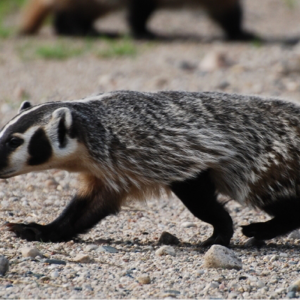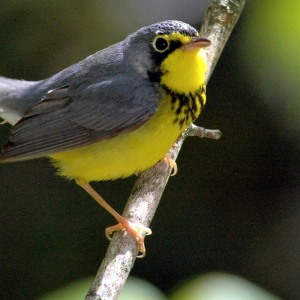Porbeagle Shark
Vital Signs
Common name: Porbeagle Shark
Latin name: Lamna nasus
Status under SARA: Not Listed, 2014 COSEWIC Assessment Endangered
Range: In the Northwest Atlantic, Porbeagle Sharks are found from northern Newfoundland into the Gulf of St. Lawrence
Life Span: Estimated to be between 25 and 46 years
Size: Up to 3.7 m (12 feet)
Population Estimate: 180,000 in Northwest Atlantic
The Facts
- The Porbeagle is a stout shark with large eyes that help spot its prey. It is bluish- or brownish-grey on top and white underneath with a white patch on the trailing edge of the dorsal fin. It has a crescent-shaped tail and a secondary keel that effectively cuts the water during the side-to-side motion.
- No Porbeagle has ever been incriminated in unprovoked attacks on humans — probably because it lives in such cold water — but as a relative of the Mako and Great White Sharks it is among the fastest swimmers in the sea. It ranks at the very top of the food chain and is the top predator in its own territory.
- The Porbeagle Shark swallows its prey whole and feeds on a diverse group of fish and invertebrates. They eat mackerel, herring and squid in winter; cod, flounder, and other groundfish in the fall as well as less common prey such as wolfish, spiny dogfish, small crabs and shellfish. Bits of fishing line, rope, shiny packaging and plastic wrappers have all been found in their stomach contents too.
- The Porbeagle Shark is one of the most cold tolerant pelagic shark species in the world, preferring water temperatures colder than 18 °C. The Porbeagle has a countercurrent heat exchanger in its circulatory system that enables it to maintain a body temperature 7 to 10 degrees higher than the ambient water temperature.
- Both upper and lower teeth of the Porbeagle are narrow and smooth-edged. This indicates that both sets are used for grasping and that the prey is swallowed whole. The teeth are pointed and narrow and have small cusps on either side of each tooth.
- As with many sharks, the Porbeagle is segregated according to size and sex. Immature Porbeagles appear to reside primarily on the Scotian Shelf while mature Porbeagles migrate annually. Males are thought to migrate along the Scotian Shelf to the Newfoundland mating grounds in the spring followed by females. Gravid females are present from late September through December
The Story
The Porbeagle Shark is one of the fastest swimmers in the sea, but it can’t out swim the commercial fishermen who come to the Northwest Atlantic from around the world looking for its highly-valued meat. The shark’s population is nearly its lowest ever, but things are looking up for this endangered species. Thanks to major cuts in fishing quotas of the Porbeagle Shark over the last several years, it is slowly recovering.
In 1961, the Porbeagle Shark was plentiful in the Northwest Atlantic. But in just six short years of hard fishing, Norwegian fishermen drove the population down to unsustainable numbers. Over the next 30 years, a few hundred tonnes were caught each year until the Canadian fishermen got involved and increased the catch to as much as 2000 tonnes a year.
Steven Campana, senior scientist at the Bedford Institute of Oceanography and head of the Canadian Shark Research Lab, says the quota was cut by 80 per cent in 1998. It was cut back even further in 2001 and 2006. “Now the quota from all sources is 250 tonnes of which 185 tonnes can be from the direct fishery and the remainder is reserved for porbeagles that are caught accidentally.”
Campana says the Porbeagle is notable for sharing many life history characteristics with humans. For instance, female Porbeagles become sexually mature at 13 and have a gestation period of nine months. They also produce very few young compared to other sharks; about four at a time. They live to be about 40 years old in our waters, but in New Zealand they can live to be about 70. Given its late maturity and low fecundity, this species is particularly vulnerable to overexploitation.
Campana says the Porbeagle is one group of sharks we can proudly call Canadian. “It’s not one that spends most of its time in international waters; it spends most of its time in Canadian waters.”
What is Being Done
The biggest step in saving the Porbeagle Shark was taken in 1998 when fishing quotas were cut by 80 per cent. Apart from the further quota reductions, which Campana says commercial fishermen have been very supportive of, one fishing area has been closed. When the Department of Fisheries and Oceans realized through their research of this species that the area south of Newfoundland was a mating area for the porbeagles, they closed it to all shark fishing.
“This is one of the few examples where it’s very tough for the general public to help much,” says Campana. “The majority of porbeagles are well offshore and down deep, 100 m or so. The average person is never ever going to run into one; even recreational fisherman will seldom catch one. So really, the only people who run into Porbeagles are the commercial fishermen who are looking for them.”
Campana says fishermen have been quite careful about releasing one year old sharks. “They want them to live and they put them back carefully.”
What You Can Do
If you’re interested in the Porbeagle Shark and want to help protect them, one of the most powerful things you can do is call your local MP and tell him or her that you support the government’s research on sharks. To learn more visit the Canadian Shark Research Lab,the only lab in Canada dedicated to doing shark research in Canadian waters.
Resources:
Species at Risk Registry (SARA)
COSEWIC Assessment
Written by Melanie Furlong, a freelance writer in Lower Sackville, Nova Scotia.


